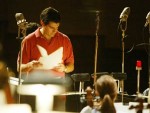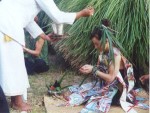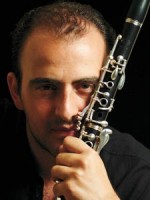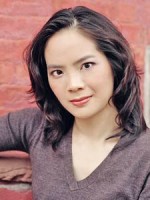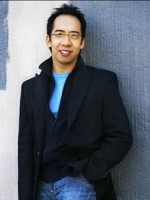Title
Subhead
Ana Valdes-Lim uses a metaphor about small boats in the ocean when she talks about performing arts throughout the world. Valdes-Lim (Group 13, drama) acts, directs, writes and, “before all that,” teaches theater at Assumption College in Makati City, Philippines. “I want my students to honor their individual small-boat responsibilities but know that the small boat lives in a wide open sea, an ocean that is the universe,” she says. “Getting over small-boat issues and sailing out into the bigger world takes us to an open universe. Don’t just tie your little boat to another little boat, cross-culturally, but take it out to the open sea. And experience the higher plane of global art. Then you can really connect, which is what I think the goal of global artists should be.”
Body
It sounds like a journey for the brave. And indeed some of the bravest who studied at Juilliard have sailed off in their small boats, bypassing the safe harbor of tradition, the comfortable coves of Mozart, Beethoven, Shakespeare, Strindberg, Balanchine, and other classics of the concert hall and stage to find great adventure and immense satisfaction in the vast global ocean. And they are starting to make some mighty impressive waves while navigating these less familiar, but exhilarating, waters of discovery beyond their native borders.
Last year Valdes-Lim, 47, who has experience directing everything from the dramatic tragedy of Shakespeare’s Romeo and Juliet to a celebratory show of song and dance excerpts from Broadway musicals, connected with an audience of thousands, representing most of the world’s continents, in Assumption Day, a show that she co-wrote, directed, and took to the Vatican. Diane Butler (B.F.A.’83, dance), born in Ohio, lives and dances in Tejakula, North Bali. Kinan Azmeh (M.M.’03, Graduate Diploma.’04, clarinet) plays his clarinet from New York City to Israel to China and beyond, returning every three weeks or so to his home orchestra in Damascus, Syria. And Miguel Harth-Bedoya (M.M. ’93, orchestral conducting), the Fort Worth Symphony Orchestra’s music director, has put forgotten music of his native Peru and other South American countries back on the map. Perhaps all this far-flung creativity hasn’t (yet) reached tsunami force and proportions, but hold tight to your cushy, red-velvet Carnegie Hall seats.
I asked some of those who, in one way or another, have multinational identities what makes their art “global.” That’s a convenient label, but is there depth, a definition? Do these performers apply the term to their own creativity? And what kind of expectations does the term conjure for audiences? Modern restaurant chefs have tinkered with adding dashes of lemongrass and wasabi to classic French cuisine—calling it Asian fusion—or have splashed sizzling Caribbean spices on Florida seafood to make “Floribbean” food. But in the culinary world, these experiments haven’t amounted to much more than a flash in the pan, creative fun, yet ultimately a fad. Is something broader and more complex stirring among performing artists? And how exactly do they design their individual global menus? With non-Western appetizers? Traditional entrees? Dessert samplers? Pairings of ethnicities, like the complimentary tangs of a South African sauvignon blanc and Thai beef salad?
“My work is an intercultural dialogue,” says Butler, 46, a movement artist and teacher, who started her East-West dialogue with Buddhism and meditation in New York, receiving Mahayana Buddhist vows in 1986. “I don’t use the word global—it has such an all-encompassing quality that feels like a takeover—but in practice I am concerned with how different cultures dialogue with each other. What is the exchange and creative process? That changes all the time. And I am always trying to awaken my expression, be inspired by a garden, a monastery, even at home—wherever I am.”
The term global (but, please, “not fusion—or worse, world”) works for Azmeh, 31, who grew up speaking two languages and simply finds his clarinet a facile instrument for moving among cultures and musical idioms—from symphonic works by Arabic composers to clubs in the East Village to mainstream jazz and chamber music. Harth-Bedoya, 39, who last month premiered Mariel for cello and orchestra by Osvaldo Golijov (Argentine-born, of Eastern European heritage, U.S.-trained, who uses musical polyglot liberally and whom many consider the prime example of a global composer) at Carnegie Hall with the Fort Worth Symphony, considers the term useful for “finding a frame for better understanding but, hopefully, not for a cliché.”
Of course, it’s not just the birth certificates or exotic stamps in these artists’ passports that makes them global, but their baggage—what they take with them from home, from places they’ve chosen to live, from places they visit and study—and how they put all the pieces together and share them. As each performer I spoke with traced his or her creative route, the importance of home emerged, a cynosure for some, a departure point for others. “We all start with a home,” says New York-born pianist Joel Fan (Pre-College ’87), whose parents are from Taiwan. “Then we can go other places. If you are not first a master of your own tradition, you have a problem with credibility. Juilliard training was my home, the Western European tradition. And then I studied with Leon Fleisher, who follows in a line of great master artists leading directly back to Beethoven.”
After his formal study, global music grabbed Fan’s attention. “It was mind-blowing, the reach of the music by so many of the composers [I started discovering].” Not only did he expand his repertory, but the world of sound grew, perhaps unexpectedly, for him. “As a pianist, learning a piece, I was taught to think about orchestrating it—the colors, what might the violins be playing or the winds,” he explains. “And when you start thinking of non-Western instruments, you can really extend.” But it is not a quick-listen kind of exercise. “You need to get under the hood of the sound world of these composers—and then show the new sounds in context.” Fan, 38, will make his New York recital debut on March 14 at the Metropolitan Museum of Art, playing Beethoven, Chopin, Liszt, and also Villa-Lobos (Choros No. 5, “Alma brasileira”), Chen (Instants d’un Opera de Pékin) and Saygun (Pentatonic Sketch on Aksak Rhythm)—eclectic programming which has become a Fan trademark.
He is also a member of the Silk Road Ensemble, the collective of musicians under the umbrella Silk Road Project, founded by cellist Yo-Yo Ma (Professional Studies '72, cello) a decade ago, to explore ideas and aesthetics that have been borne along the ancient trade routes that connected Europe, Central Asia, and the Far East—the shining example of global arts. For many Western audiences, a Silk Road performance may have been the first hearing of a morink khuur (Mongolian horsehead fiddle), which Ma also plays, or a jang-go (Korean hourglass drum) or samtur (Persian hammer dulcimer). Or any work by composers outside the West, such as Franghiz Ali-Zadeh from Azerbaijan, or Mustafa Bafoyer from Uzbekistan. The ensemble has several dozen such commissions in its repertory, along with traditional music, and uses visual art in its programs as well.
Ma’s ideas about fitting more pieces of the world’s cultures into a large mosaic filled with texture and color have some predecessors. Even Mozart wrote what he knew of as Turkish Janissary band music (heavy on the percussion) for the overture and some choruses in The Abduction From the Seraglio. Eastern imports (think coffee houses) were exotic and fashionable in Vienna then; and the opera is set in Turkey. In the early decades of the 20th century a steadfast handful of composers took to serious study of Eastern sound and infused their own works with what they heard. Impressionists such as Debussy explored pentatonic scales, historically associated with China and Polynesia. Indeed the Silk Road Ensemble programs pieces by Debussy and Ravel (of Basque heritage, who lived mostly in France).
But well before the Silk Road Project, and on the coattails of the French Impressionists, some Americans composed from a more colorful, enriched sound palette. “Henry Cowell got all this [global music] started,” says Juilliard faculty member Joel Sachs, who is working on a biography of Cowell. “He lived in a poor neighborhood in San Francisco that was home to many immigrants. So he grew up learning Asian sounds. He once said that no one ever told him Western music was supposed to be better. He did go on to study in Berlin. But he always incorporated ideas from other cultures.” Others followed his example, including his students John Cage and Lou Harrison. And Colin McPhee spent years, after absorbing what he could from recordings, living in Bali.
Sachs, 67, who directs Juilliard’s Focus! festival, which many graduates remember as an ear-opening introduction to global art, recalls the 1960s and how that affected his own career. “It was really starting to take hold then,” he says. “Ravi Shankar [the Indian sitarist] toured and played with the Beatles and with [violinist] Yehudi Menuhin. That was a revelation. Then the day after I graduated from college, I went off on an Asian tour with a choir.” Sachs has continued accumulating frequent-flyer mileage, regularly visiting Poland, the Czech Republic, Hungary, Mongolia, Korea, Japan, Indonesia, Uzbekistan and many of the other “stans” (mostly former Soviet states), participating in artistic exchanges and bringing back music of composers in those lands to be heard in America. “Isolationism is never a good idea,” he says. “Having recognition of alternate cultures, we are better off.”
Vivian Fung (B.M. ’96, M.M. ’97, D.M.A. ’02, composition), Sachs’s Juilliard faculty colleague, agrees. A composer, she co-directs World Music at Juilliard, which she hopes will help students think outside the conservatory box. “The catalyst for this series, which started in 2005, was an exchange program in Bali. There I worked with a gamelan ensemble and invited them to come to Juilliard. We have also had an Afghan group, a Flamenco guitarist from Spain (with a local group to demonstrate dance), and Taiwanese court musicians,” she says. Fung, 32, whose parents are Chinese, grew up in Canada. “I am Western-trained but my [works might be called] Western-style with Asian elements infused. My journey is not like that of someone who grew up in China. I did listen to Chinese folk songs at home, but my first time in China was 2002, when the American String Quartet toured there to play a piece I wrote for them. I was surprised to find that a lot of traditions are being lost: Beijing Opera? No. Rock music? Yes. But libraries still make a lot of history accessible.”
Miguel Harth-Bedoya also searches libraries (as well as attics and other personal collections) for composers of the Inca Trail. Fifteen-thousand miles of actual paths did unite the Renaissance-era Tahuantinsuyo Empire. His concept differs somewhat from that of his colleague Yo-Yo Ma (the two performed Golijov works with the Boston Symphony Orchestra earlier this season, and Harth-Bedoya conducted a recording of the Chicago Symphony Orchestra with the Silk Road Ensemble). Instrumentation of the works Harth-Bedoya is uncovering is all Western, for one thing. “I don’t know of any South American country that has been collecting and preserving symphonic works consistently,” he says. “Even libraries don’t always know what they have. Most works I find are signed manuscripts. Some of the composers studied and worked in Europe—such as Antônio Carlos Gomes, who wrote operas for La Scala, then returned to Brazil.” With the works now slowly being edited and published, Harth-Bedoya has led Caminos del Inka (Inca Trail) programs with his Fort Worth Symphony and elsewhere. “It was my idea to use the trail—something physical that has united people—and also to [incorporate other images in the program format] to give audiences outside South America some orientation. I really hope others will play this music. The whole idea is that it can be done by anybody.”
Taking these kinds of research and programming initiatives fulfills several roles. Joel Fan says, “As artists it is our job to both preserve and extend an art. And we have to think globally—that helps us understand macrotrends and ourselves. Look at what’s happening around the world ... Music, from almost anywhere, is now available at the click of a mouse, but does not happen separately from anything else.” Vivian Fung agrees: “Our society has gone global—from imported food to the stock market. It is no longer possible to work in a vacuum.”
So, does that mean performing arts mix with politics? Some say, absolutely not. For others, impossible to avoid. Kinan Azmeh, with a congenial, easy laugh, says, “I’d love to be described as political. I think we all are today, because politics affects our daily lives. I come from a place that is stereotyped: Syria. Arabs. Terrorism.” He details involved security searches at airports and how he sometimes turns his anger into beautiful music. “But I want to share with people what I have and defy stereotypes. People ask about camels! They say, ‘Oh, do people in Syria play the clarinet?’ I may be the only Syrian they will ever meet, so in a way, I am an ambassador. I always try to put a piece of mine and a piece of another Arab composer on my recital programs [along with Brahms].”
That sounds inviting to me—a visit to unfamiliar places his programming might take me. To return to the metaphor of Ana Valdes-Lim, have all these little boats of global artists riled the waters permanently, provoked a sea change? We will have to keep testing those waters—concert halls, presenters, programmers—to see. And that will make for many exciting, enlightening journeys.


